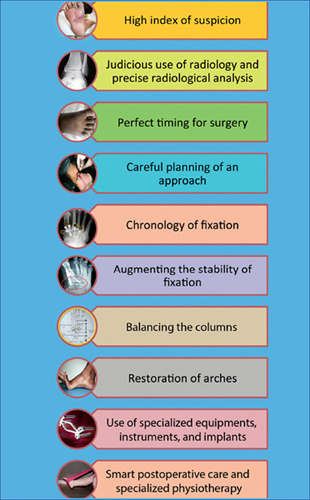Chapter Foot and ankle trauma is different! For good outcome of foot and ankle trauma, it is mandatory to strictly adhere to specific management principles. They are best described as the “Ten commandments of foot and ankle trauma management.” and are illustrated in Fig. 5.1. Many of the foot and ankle fractures can be easily missed, if not suspected! Quality of high index of suspicion would rescue a surgeon in many situations because, if missed, these injuries would lead to long-term disability. Commonly missed or misdiagnosed foot and ankle injuries are as follows: ♦ Syndesmotic ankle sprain ♦ Subtalar joint sprain ♦ Anterior process of calcaneus fracture ♦ Lateral talar process fracture ♦ Posterior process talus fracture ♦ Osteochondral fractures of talus ♦ Fifth metatarsal base fracture ♦ Tendo Achilles rupture ♦ Peroneal tendon injury (all the aforementioned conditions can be mistaken for ankle sprain) ♦ Ankle and midfoot fractures associated with neuropathy (careful history taking, clinical examination, and monofilament testing would differentiate neuropathic fracture) ♦ Lisfranc injury (it could be misdiagnosed as midfoot sprain. Plantar ecchymosis, clinical examination, weight-bearing X-rays, and stress tests would lead to precise diagnosis) ♦ Cuboid fracture (midfoot bones are like forearm bones where isolated injury of one is rare and will almost always be associated with radiologically undetectable subtle injury of others. Specialized as well as comparative X-rays together with careful clinical examination would lead to diagnosis) ♦ Sesamoid injuries (mode of trauma, careful clinical examination, and specialized radiology would support suspicion) ♦ Stress fractures (specialized investigations such as CT scan, bone scan, and MRI shall follow suspicion of stress fractures, more so in athletes and weekend warriors) Radiology plays a vital role in the diagnosis as well as management of foot and ankle trauma. Familiarity to specialized radiological views is mandatory. Careful analysis of radiology is equally important. Importance of weight-bearing radiology cannot be overemphasized in foot and ankle trauma care. Reader is referred to Chapter 2 of this book for further reading. Table 5.1 summarizes about the pivotal role radiography plays in diagnosing and managing different traumatic conditions in foot and ankle. Table 5.1 Injury-specific radiology
5
Ten Commandments of Foot and Ankle Trauma Management
Commandment No. 1: High Index of Suspicion!
Commandment No. 2: Judicious Use of Radiology and Precise Radiological Analysis
| Condition | Specific radiology | Remarks |
| Ankle fractures | AP, LAT, and OBL ankle views | Look for nine ankle radiology signs |










